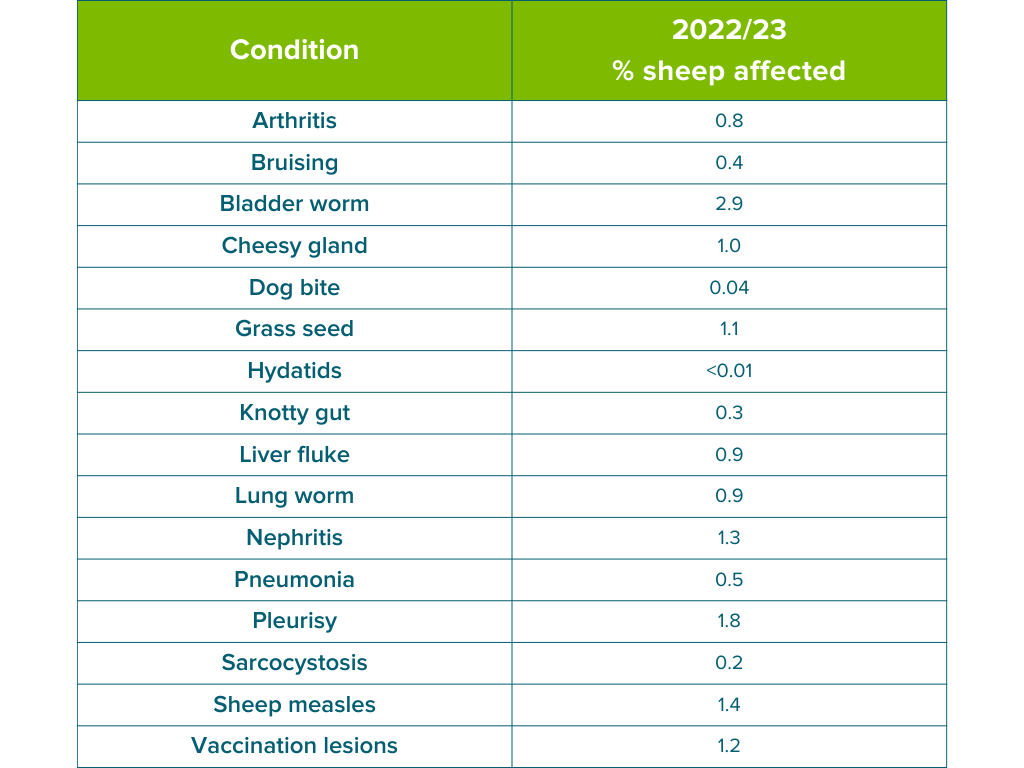Read the latest information on
Foot-and-mouth disease
The National Sheep Health Monitoring Project (NSHMP) Annual Report provides a snapshot of the health of the Australian sheep flock. The NSHMP has been running since 2007, and now collects data from 10 participating abattoirs for 19 sheep health conditions. These conditions are reported by qualified meat inspectors and are of economic significance for both processors and producers. While these conditions can be profit killers at the abattoir, they can also lead to reduced production efficiency and implications for animal welfare, depending on the condition and the severity to which sheep are impacted. Table 1 provides a summary of the percentage of sheep affected by each condition for 2022-23.

Table 1:
National percentage of sheep affected by each condition in 2022-2023
The aim of this project is to provide feedback to producers about the conditions occurring in their sheep, allowing them to adapt their management practices to address the sheep diseases most significant to them. Producers can also access data specific to their own lines of sheep via Meat and Livestock Australia’s myFeedback.


Figure 1:
Percentage of sheep affected by bladder worm in each Local Government Area in 2022-2023
Bladder worm has now been the top condition for three years in a row and was most common in New South Wales, where 4.5% of inspected sheep had the condition. It was also observed quite extensively in Tasmania, with 71% of participating properties having at least one affected animal during 2022-23.
Bladder worm is caused by infective cysts from the dog tapeworm Taenia hydatigena which are found in the sheep’s liver and abdominal cavities. Similarly, sheep measles are infective cysts caused by the dog tapeworm Taenia ovis and are found in the muscles of sheep. Most losses to profit are seen at the abattoir due to carcass trimming and offal condemnation, with higher levels of sheep measles likely to lead to full condemn. Figure 1 shows a map of the distribution of bladder worm according to local government areas (LGAs).
There is no treatment for bladder worm and sheep measles, therefore prevention is the best way to manage this condition. The dog tapeworm lifecycle must be disrupted by ensuring all farm and house dogs are wormed monthly with a wormer containing the active ingredient praziquantel, which kills these tapeworms. Furthermore, you can prevent dogs from becoming infected by restricting their access to sheep carcases and raw sheep meat, therefore avoiding the ingestion of infective cysts.

The occurrence of pleurisy has increased over the past three years and is a resulting condition of severe pneumonia where the infection has extended to the outer layer of the lung, known as the pleura. This can cause parts of the lung to adhere to the chest wall, leading to costly trimmings at the abattoir and damage to the valuable rib rack.
Reducing the occurrence of pleurisy requires the effective management of pneumonia in sheep, which includes preventing exposure to irritants within their environment. Excessively dusty and dry conditions, inhalation of drenches and dips as well as stress can all increase the risk of respiratory infections in sheep. Consider reducing the time sheep spend in yards during dry and windy conditions, preventing overcrowding, and taking your time when driving them back to their paddocks. If levels of pneumonia/pleurisy detected are high, it may be worthwhile testing sheep to determine which pathogens are causing the pneumonia (talk to your veterinarian about this).
With the official declaration of El Niño by the Bureau of Meteorology, it’s possible that we may see a shift in the prevalence of some conditions, especially those that were exacerbated by high rainfall such as grass seed lesions and some internal parasites, such as liver fluke.
The NSHMP Annual Report 2022-2023 publication is now available for viewing and for download via the Animal Health Australia website – National Sheep Health Monitoring Project 2022-2023 Annual Report – Animal Health Australia